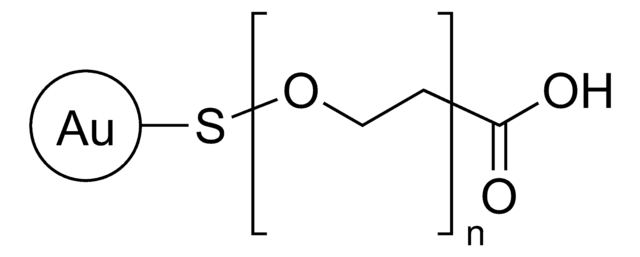Key Documents
765708
Gold nanoparticles
15 nm diameter, OD 50, methyl terminated, PEG 5000 coated, dispersion in H2O
Synonim(y):
Gold nanoparticles OMe terminated, Au NP OMe, Gold Colloid
About This Item
Polecane produkty
Materiały
PEG 5000
Poziom jakości
Postać
dispersion in H2O
nanoparticles
opakowanie
poly bottle of 1 mL
OD
50
średnica
15 nm
pH
6.0-8.0 (25 °C)
rozpuszczalność
water: miscible
gęstość
1.00 g/cm3
λmaks.
520 nm
grupa funkcyjna
methoxy
temp. przechowywania
2-8°C
Szukasz podobnych produktów? Odwiedź Przewodnik dotyczący porównywania produktów
Opis ogólny
Zastosowanie
- Since they adhere to cell membranes, AuNPs may find use in cellular and intracellular targeting in targeted drug delivery applications and may also used in biodistribution studies.
- AuNPs may also be used in photothermal therapy and radiotherapy.
- AuNPs ranging from 10 to 250 nm, were studied to have been absorbed primarily by liver and spleen, when injected intravenously in rats.Whereas, 10 nm nanoparticles were distributed more broadly into various organs.
Cechy i korzyści
Kod klasy składowania
12 - Non Combustible Liquids
Klasa zagrożenia wodnego (WGK)
WGK 1
Temperatura zapłonu (°F)
Not applicable
Temperatura zapłonu (°C)
Not applicable
Wybierz jedną z najnowszych wersji:
Masz już ten produkt?
Dokumenty związane z niedawno zakupionymi produktami zostały zamieszczone w Bibliotece dokumentów.
Klienci oglądali również te produkty
Produkty
Biomaterials science involves the design and fabrication of smart materials for studying, directing, or mimicking biology. For successful integration of biomaterials in biological research, a meaningful understanding of biological systems is required.
Nasz zespół naukowców ma doświadczenie we wszystkich obszarach badań, w tym w naukach przyrodniczych, materiałoznawstwie, syntezie chemicznej, chromatografii, analityce i wielu innych dziedzinach.
Skontaktuj się z zespołem ds. pomocy technicznej


